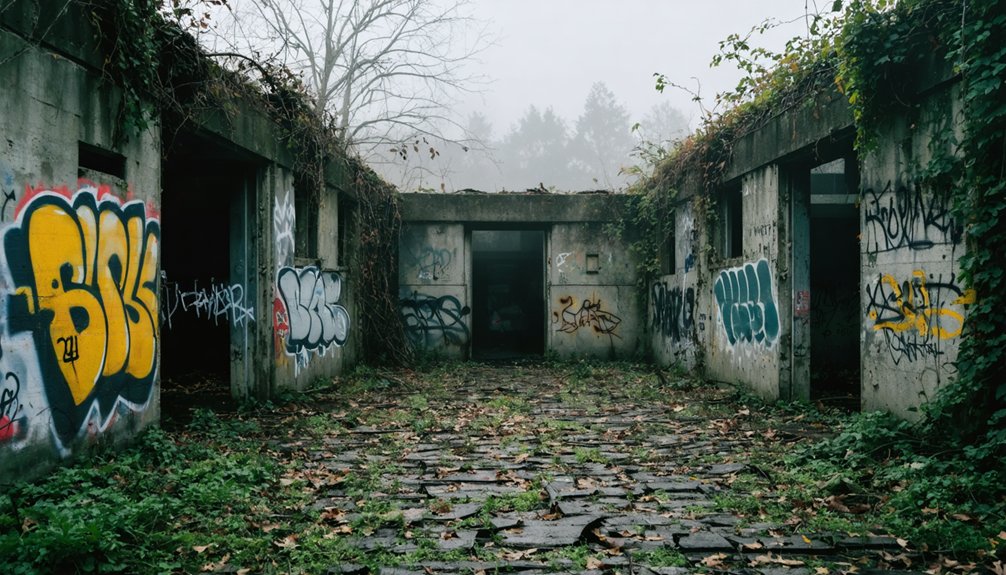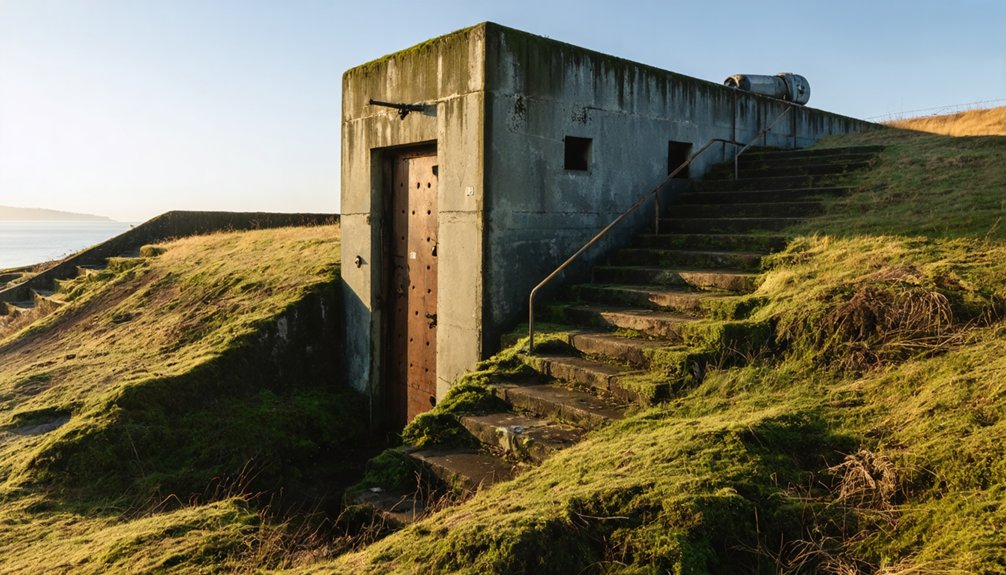America’s abandoned military bases offer fascinating glimpses into our defensive past. You’ll find Fort Ord’s 28,000 acres slowly returning to nature, and Fort Jefferson’s massive unfinished brick fortress harboring Civil War secrets. Fort Monroe balances historical preservation with reported ghost sightings, while coastal Forts Tilden and Morgan showcase deteriorating defense structures. Scattered across rural America, Cold War missile silos stand as underground time capsules of the nuclear age. These five sites reveal much more than their crumbling facades suggest.
Key Takeaways
- Fort Ord in California spans 28,000 acres and was closed in 1994, now undergoing nature reclamation.
- Fort Jefferson, America’s largest brick structure, was abandoned in 1874 due to yellow fever and water contamination.
- Fort Monroe was decommissioned in 2011 and is now a National Historic Monument known for paranormal activity.
- Coastal defense sites Fort Tilden and Fort Morgan feature deteriorating structures that preserve military history.
- Abandoned missile silos from the Cold War era represent the nation’s former nuclear deterrent system.
Fort Ord: California’s Military Ghost Town Reclaimed by Nature
Nestled along the picturesque Monterey Bay in California, Fort Ord once stood as one of America’s most coveted military installations, spanning an impressive 28,000 acres between the cities of Seaside and Marina.
Originally purchased in 1917 as Gigling Reservation, it was renamed Fort Ord in 1940 and became the nation’s primary training center during Vietnam. The military legacy includes massive 1950s construction projects costing over $20 million, with 31 dormitories housing 7,000 men. The base was historically significant as the first racially integrated military installation in the United States.
Fort Ord evolved from humble Gigling Reservation roots to become Vietnam’s premier training ground, marked by ambitious mid-century expansion.
Following 1991 BRAC recommendations, Fort Ord closed in 1994.
Today, nature reclamation is evident throughout the crumbling facilities, where asbestos hazards remain. The site underwent significant transformation through educational institutions like California State University, Monterey Bay, which emerged on the former military grounds. The site’s transformation includes the 2012 establishment of Fort Ord National Monument and development of Dunes State Park, though coastal erosion now threatens remaining structures.
The Haunted Fortress: Fort Jefferson’s Abandoned Island Stronghold
Rising from the turquoise waters of the Florida Straits, Fort Jefferson stands as America’s most remote military ghost, a stark contrast to California’s inland Fort Ord.
This six-sided colossus of 16 million bricks—North America’s largest brick structure—began construction in 1846 but was never completed. Its haunted history includes housing Lincoln assassination conspirators, most significantly Dr. Samuel Mudd, while its military architecture featured capacity for 243 guns that never fired in combat. Located 68 miles west of Key West in the Gulf of Mexico, this massive fortress covers approximately 16 acres of its 47-acre island.
You’ll find a fortress rendered obsolete by rifled cannons before completion, abandoned officially in 1874 after decades plagued by yellow fever, structural settling, and contaminated water cisterns. Like Fort Proctor, it fell victim to strategic reprioritization when the Civil War diverted attention elsewhere.
The Army, Navy, and Marine Hospital Service each controlled this crumbling giant before its 1935 monument designation.
Today, you can explore its underground tunnels while witnessing nature reclaim this isolated sentinel.
Historic Fort Monroe: From Military Stronghold to Paranormal Hotspot
Built as a strategic coastal fortress in 1819, Fort Monroe stands as America’s longest continuously operating military installation until its 2011 decommissioning.
During the Civil War, it remained the only Union-held federal fortress in the Upper South, serving as headquarters for military operations under Major General Benjamin Butler.
Today, you’ll find “Freedom’s Fortress” transformed into a National Historic Monument managed jointly by the Fort Monroe Authority and National Park Service.
The site’s paranormal reputation attracts visitors seeking supernatural encounters—Confederate President Jefferson Davis’s ghost reportedly haunts the ramparts, while Lincoln’s spirit has been spotted in various locations.
You can experience these phenomena yourself through candlelight paranormal tours, where guides reveal accounts of shadowy figures, unexplained cold spots, and disembodied voices that echo through this historic stronghold’s stone walls that measure 10 feet thick.
The fort’s most infamous area is Ghost Alley, known for frequent paranormal encounters and a central highlight during the annual ghost walks held each fall.
Fort Tilden and Fort Morgan: Coastal Defense Ruins Frozen in Time
Once serving as critical components of America’s coastal defense system, Fort Tilden and Fort Morgan now stand as deteriorating relics of military history, their crumbling structures offering windows into different eras of national security strategy.
Fort Tilden, established in 1917 on New York Harbor, evolved from housing 12-inch mortars to supporting Cold War Nike missiles before deactivation in the 1970s.
From protective mortars to Cold War missiles, Fort Tilden’s silent batteries chronicle America’s evolving coastal defenses.
Today, you’ll find its casemates and batteries covered in graffiti, with many structures dangerously unstable and contaminated.
Fort Morgan, an 1834 Third System coastal fortification in Alabama, defended Mobile Bay during the Civil War through WWII.
Its massive masonry walls—8 feet thick and 40 feet high—surround a parade ground and numerous gun emplacements that remain intact.
Both sites preserve distinctive chapters of American military history despite their decay.
The abandoned Munitions Response Site at Fort Tilden contains multiple military batteries including Battery Harris and Battery Kessler that once protected New York Harbor from potential threats.
Fort Tilden’s decommissioning in 1974 transferred the site to the National Park Service, allowing public access to this historical military landscape.
The Silent Sentinels: Abandoned Missile Silos and Cold War Relics
Deep beneath America’s heartland, concrete giants of the Cold War era stand in silent vigilance—remnants of a nuclear arsenal that once represented the nation’s ultimate defense.
In the late 1950s, the U.S. deployed 1,000 Minuteman missile silos across the Midwest, with twelve Atlas silos dotting the Adirondack region alone. Construction began in 1959 under strict government secrecy, with locals being told the activity was merely routine surveying.
These 18-story underground chambers, reinforced with steel and sealed by hydraulic blast doors, housed America’s nuclear deterrent during the height of Cold War tensions. Like Camp Century in Greenland, they were designed to withstand harsh environments while concealing weapons of mass destruction from enemy detection.
Frequently Asked Questions
Can Civilians Legally Explore These Abandoned Military Bases?
No, you can’t legally explore abandoned military bases. They remain federal property with strict legal restrictions on civilian access, and unauthorized entry constitutes a federal trespassing offense with penalties.
What Dangerous Substances Might Remain at These Sites?
Walking on thin ice, you’ll face toxic remnants including PFAS, benzene, TCE, lead, radioactive materials, and VOCs. These environmental hazards persist in soil and groundwater, threatening your freedom and health.
Are There Guided Tours Available at Any Locations?
Yes, you’ll find guided exploration options at several sites including Devil’s Slide Bunker, Fort Ord, and the Presidio, where tours highlight each location’s historical significance through structured visits.
Which Base Has the Most Reported Paranormal Activity?
Fort Leavenworth tops the list with 36 haunted buildings. You’ll discover its rich Haunted History through Tower 8’s ghostly calls and The Rookery’s multiple specters. These Eerie Experiences include vanishing objects and full apparitions.
How Have Local Communities Repurposed Parts of These Bases?
You’ll love seeing Uncle Sam’s old war rooms transformed into Amazon warehouses! Communities have embraced adaptive reuse through business hubs, housing developments, transportation infrastructure, and recreation spaces—all achieved through intensive community involvement spanning decades.
References
- https://devblog.batchgeo.com/ghost-towns/
- https://www.operationmilitarykids.org/abandoned-military-bases/
- https://www.loveexploring.com/gallerylist/233478/americas-eeriest-abandoned-military-sites
- https://www.youtube.com/watch?v=pcX5nv0XhCA
- https://www.geotab.com/ghost-towns/
- https://www.youtube.com/watch?v=_GXPCLi66xw
- https://www.popularmechanics.com/technology/design/g1507/creepy-abandoned-military-sites-from-around-the-world/
- https://www.youtube.com/watch?v=mFX-zQuWUo4
- https://www.youtube.com/playlist?list=PLenYgd5YLQJ744EWXrjBFt-EtBj8FFdPo
- https://abandonedwonders.com/tag/abandoned-military/



